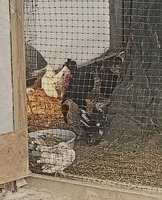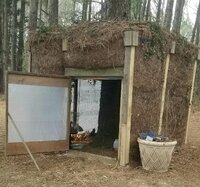Navigation
Install the app
How to install the app on iOS
Follow along with the video below to see how to install our site as a web app on your home screen.
Note: This feature may not be available in some browsers.
More options
You are using an out of date browser. It may not display this or other websites correctly.
You should upgrade or use an alternative browser.
You should upgrade or use an alternative browser.
TENNESSEE COOP ON A FIXED INCOME
- Thread starter nchls school
- Start date
Pics
More options
Who Replied?urbanhenhouse
Chirping
Wow, looks like a great low-budget coop!
- Thread starter
- #3
Thank you. The pictures make it look really crooked; it isn't.
A couple months ago we had a severe storm; high wind and lots of rain. The coop lost its roofing and was heavily damaged. We had another storm early this morning with the same conditions-no damage to anything other than fallen branches. Unlike last time my flock was safe and dry.
A couple months ago we had a severe storm; high wind and lots of rain. The coop lost its roofing and was heavily damaged. We had another storm early this morning with the same conditions-no damage to anything other than fallen branches. Unlike last time my flock was safe and dry.
HenOnAJuneBug
Crowing
- May 20, 2015
- 2,719
- 5,788
- 392
Why don't you explain the construction details?
- Thread starter
- #5
When my wife and I moved here four years ago there was a big tree house in the backyard with four 4x4x8 uprights and a heavy plank floor. My coop is the four uprights; the roof being the tree house floor.Why don't you explain the construction details?
At first we simply screened in the uprights, with a door, to make a warm-weather run. As the weather cooled plastic sheeting was put over the screen to prolong the run's use. As that first winter approached we soon learned that the "plastic" coop stayed warmer than the wood one. From there shipping blankets and black plastic were used to cover two walls that faced west and north to provide better protection. (A really ugly thing, but it kept the birds fairly comfortable.)
With that storm a while back the tree house was blown away exposing the plank floor to the elements. The inside of the coop got soaked including the serama. I ended up losing a few very young birds from getting chilled.
Something had to be done immediately, so I stretch a heavy tarp over the planks and stapled the edges. From there storm fallen branches were placed on top to hold the tarp in place-then pine needles-then leaves-then some top soil. I collected plants around the yard (English ivy, honey suckle, hummingbird vine, decorative grasses, etc.) and planted them on the top. A roof-top garden of sorts.
When my wife suggested doing something about the ugly walls I stretched garden netting over the shipping blanket/black plastic wall and stuffed it with pine needles, leaves, and some soil. More English ivy was planted on the walls. For trim work I used some extra boards from the garage and some from the wrecked tree house.
The clear plastic side faces south and it was quickly apparent that the coop stayed too warm. More netting attached to a 2x2 made a drop down curtain for the door. Most days, if the sun shines, the door stays open; even when the outside temperatures are in the low twenties. The door has bungy cords attached to either hold it open or to close the door when I enter when the weather is cloudy and cold.
When spring gets here the plastic will be removed from the front and the door so the coop will be well ventilated. Late spring and summer here often means 90+ degrees. The heat is more a concern than the winter cold as there'a lot more hot days than cold ones. The big pine that the coop is around provides shade from the hottest mid-day sun and some shelter from storms.
Mid-January and there's new growth on the ivy and honey suckle already. When the coop become ivy covered it will be a most unique hen house.
Would love to see the framework under all the 'organics'.Why don't you explain the construction details?
Does the roof shed water?
- Thread starter
- #7
Yes, the water seeps through the materials on the roof and what's not absorbed drips of the front. The roof has a slight slant to the front.Would love to see the framework under all the 'organics'.
Does the roof shed water?
The framework is four 4x4 uprights with 2x4 horizontals halfway between roof and floor.
New posts New threads Active threads
-
Latest threads
-
New to the Flock are BREEDS ACCURATE?!
- Started by The Five O
- Replies: 0
-
-
-
-
-
-
Threads with more replies in the last 15 days
-
-
-
-
Please Help! Eggbound & Possible Prolapsed Vent
- Started by Elspeth Dinsmore
- Replies: 97
-
2 week old chick labored breathing, gasping, lethargy
- Started by RandomAnarchy
- Replies: 88
-





